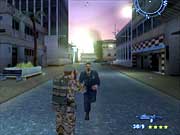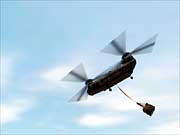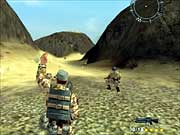Conflict: Desert Storm Preview
We take a look at this action game that depicts one of the most one-sided wars in history.
The Persian Gulf War was perhaps the most one-sided conflict in recent history. Launched by the United States and a coalition of international forces on January 16, 1991, the six-week war devastated Iraq and forced their eventual retreat from neighboring Kuwait. The war was also the world's most widely televised conflict, as news networks like CNN and the BBC brought home nightly images of the offensive from US airbases in Saudi Arabia, the streets of Kuwait City, and even from downtown Baghdad itself. One aspect of the war that wasn't televised, however, was the supposed secret operations of the military's special operations teams that paved the way for the US-led invasion in the days and weeks prior to January 16. According to some news reports, operations undertaken by Marines Force Recon, US Army Rangers and Delta Force, Navy SEALs, and the British SAS played a key role in ensuring victory both before and during the war. Though you probably won't see a CNN or History Channel special on these operations, newly formed publisher Gotham Games will soon let you reenact those events in the forthcoming action game Conflict: Desert Storm.

The game is currently in development at UK-based SCi and Pivotal Games, and it places you in the shoes of a squad leader for either the Delta Force or the British SAS in Kuwait and Iraq during the Persian Gulf War. Conflict: Desert Storm is split up into 15 individual missions that involve everything from rescuing POWs to scouring for and destroying Iraqi Scud missiles. Of course, before you do any of that, you'll have to go through three sessions of boot camp. You'll move about an obstacle course, become familiar with a number of weapons, and learn how to issue commands to the rest of your squadmates. Though Conflict: Desert Storm might seem like a typical action game from screenshots, first and foremost, it's a squad-based game in the mold of Rainbow Six and Rogue Spear, and like in those two games, success in every mission depends on your ability to map out and digest your target area covertly, strategically place your various squad members in key locations, and execute your orders with extreme prejudice. Of course, nothing will go according to plan, and success will often depend on being able to deal with unexpected situations quickly and efficiently.

Unlike in Halo, for example, where the Marines you often encountered were completely AI-controlled, you will be able to exert complete control over your squadmates in Conflict: Desert Storm, though if you leave them alone, they will do whatever it takes to defend themselves. In the lower left-hand corner of the game's interface, you'll see each of your team members represented by a small box. Within each of those boxes is a health meter and the last order that you've issued to that soldier. There are four different commands that you can give to your team--follow, stay, go to, and attack--and these can be issued to individual teammates or to the squad as a whole. As you can probably guess, ordering your entire squad to follow you at all times seems like the easiest way of approaching the game, and in the earlier levels, it is. However, later levels will have numerous objectives that need to be completed in a specific order, and you'll often be assaulting a much larger area than before, but with the same number of squad members. That means that you'll have to send out your sniper, for example, to a certain area of the map to cover the rest of your squad, or strategically place your heavy gunner to create a zone of fire between your squad and enemy positions.
As you progress through Conflict: Desert Storm, your missions will grow increasingly more daunting. The first few levels will involve rescuing a POW or escorting an emir through the streets of Kuwait City. Later levels, however, will have you assaulting an airbase with nothing more than your four-man team. In this specific mission, you're tasked with neutralizing the base's defenses by taking its power generator offline, destroying a number of SAM sites scattered around the base, and detonating a couple of MiG-29s that are parked in hardened bunkers, as well as their respective fuel depots. You'll have to coordinate between all the members of your squad carefully if you plan on completing missions like these successfully.
Controlling the Mayhem
Count on things not going according to plan. You'll receive an intelligence brief before every mission, but an unexpected convoy of enemy troops or an unaccounted-for tank is always just around the corner, and you'll have to react to such events quickly. Helping you accomplish this task is a varied arsenal of small arms, rifles, antiarmor weapons, and most importantly of all, your squadmates. Some missions in the game will have you flying solo, while others will provide you with only one other team member. For the most part, however, you'll go through Conflict: Desert Storm with your team of four elite special operators. Their abilities will vary greatly in order to complement each other's roles. Your team will consist of a demolitions expert, a heavy gunner, and a sniper, and you'll take on the role of the grenadier/team leader. In addition to the primary weapons that these four carry, they'll also have a number of other essential items on their person. All four of them, for example, will carry a silenced pistol that's not very effective at long range but comes in handy when they run out of ammo for their rifles. Expect your ammo supply to be a cause of worry in the game, especially in later levels and on the harder difficulty settings. Most of your guys will carry only a handful of clips with them, and the firefights that you'll engage in will often get pretty furious. Thankfully, you'll often come across enemy weapons--AK-47s, RPG-7s, and the like--during your many raids on Iraqi installations, and you'll be able to carry, equip your team with, and use anything that you find in the battlefield.

Some members of your squad will also carry frag grenades, smoke grenades, and med kits, and the demolitions expert will always carry a few satchels of C4 and a detonator. This makes things like blowing up bridges and cratering careless tanks a breeze. You'll also have the ability to call in air strikes and artillery barrages later on in the game in order to deal with several armored vehicles at once. If that's not enough firepower for you, you'll be able to hop into certain vehicles and take on the enemies from behind the barrel of an M1A2 Abrams or a Bradley APC. And just as your various teammates have the ability to make use of various weapons, so do these vehicles boast numerous ways to dispatch its targets. The Bradley, for example, has its primary 25mm cannon, as well as its 7.62mm coax machine gun, both of which can make quick work of any infantry or lightly armored vehicles. To deal with any tanks that your team might run into, the Bradley also has several TOW missiles that can penetrate thick armor.
In missions where the Bradley or the Abrams will play a prominent role, you'll often run into roadblocks or mines, and again, you'll have to use teamwork in order to clear a path for your vehicle and provide cover fire for any exposed squadmates. The game's control scheme, while complex at first, lets you perform numerous tasks at once. You can even switch between characters and do whatever needs to be done manually, if you want. You'll find that doing it that way, though, is a lot slower than ordering your squadmates around, and once you get a grasp on Conflict: Desert Storm's controls, you'll be barking orders to your team like a pro. You'll also find that, unless you're careful about manually healing the rest of your team using the med kits that you carry, your squad won't be able to stand up to a lot of firepower. While in no way does Conflict: Desert Storm model damage in an accurate manner, it is less forgiving than similar action games. Thankfully, the game does have a somewhat unique method of handling death. Once a squadmate's life bar is completely depleted, he'll drop to the ground, and his life bar will turn red. He'll slowly bleed out, and if his red energy meter is totally drained, then he'll die. If you manage to get to your fallen comrade before he bleeds to death, however, you can heal him with a med kit. If you yourself die, you'll automatically assume control of the nearest soldier. The game is over when all the members of your team are in the red or otherwise dead.
Conflict: Desert Storm has been a long time coming, having been in development since late 2000, but the game is finally nearing completion. In fact, even though it was originally announced as a PC game, it'll be out for all four major gaming platforms--the PC, Xbox, PlayStation 2, and GameCube--this fall. We'll have more on the game as its release date approaches. In the meantime, however, be sure to take a look at the latest set of screenshots and movies that we've taken from the Xbox version of the game.
Got a news tip or want to contact us directly? Email news@gamespot.com
Join the conversation